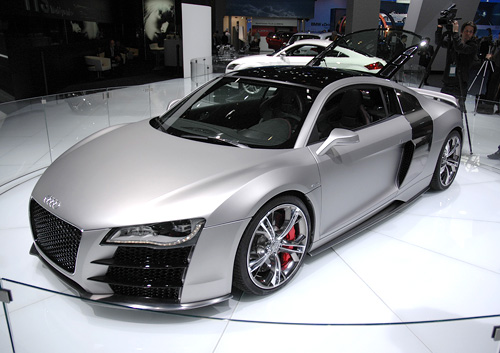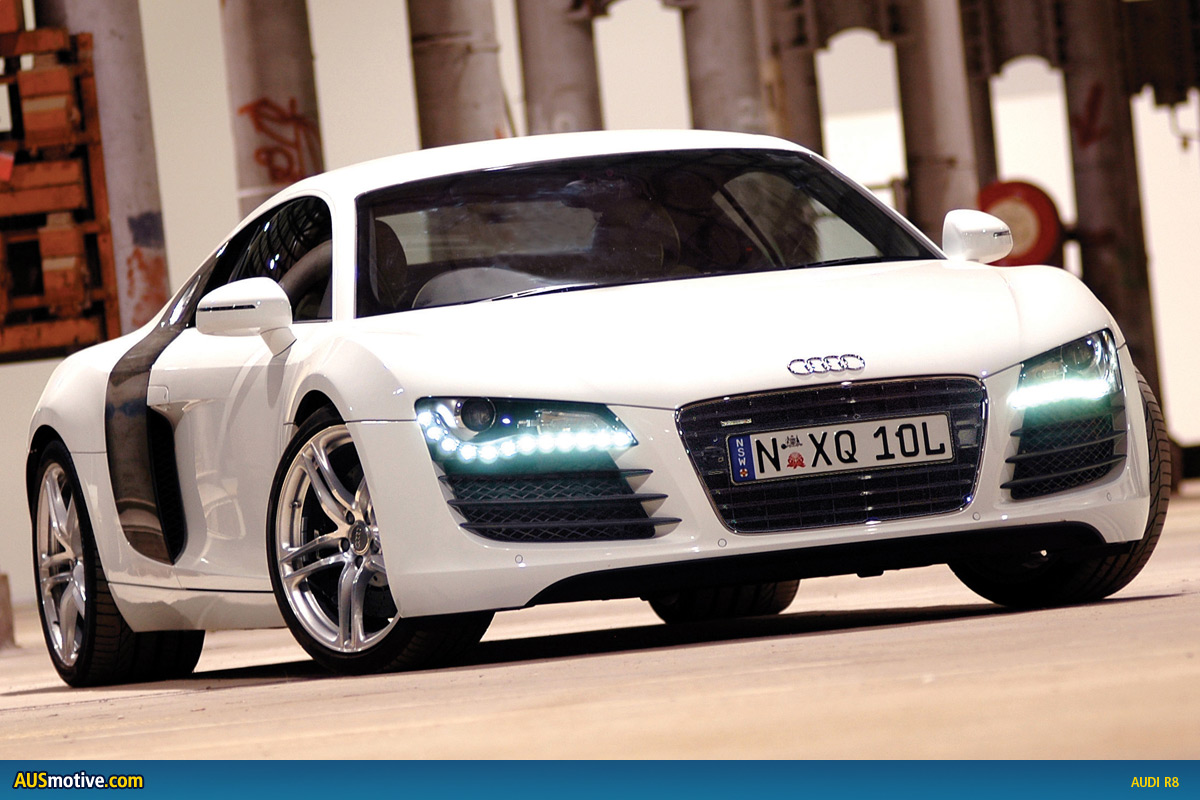

The car was exclusively designed, developed, and manufactured by AUDI AG’s high performance private subsidiary company, quattro GmbH, and is similar to the Lamborghini Gallardo.The fundamental construction of the R8 is based on the Audi Space Frame, and uses an aluminium monocoque which is built around space frame principles. The car is built by quattro GmbH in a newly renovated factory at Audi’s ‘aluminium site’ at Neckarsulm in Germany.
In 2005, Audi announced that the name of the successful Audi R8 race car would be used for a new road car in 2007, the Audi R8, based on the Audi Le Mans quattro concept car, appearing at the 2003 International Geneva Motor Show, and 2003 Frankfurt International Motor Show. The R8 road car was officially launched at the Paris Auto Show on 30 September 2006. There was some confusion with the name, which the car shares with the 24 Hours of Le Mans winning R8 Le Mans Prototype (LMP). 6-time 24 Hours of Le Mans winner Jacky Ickx described the R8 as “the best handling road car today”.
The Audi R8 is used as a safety car in Deutsche Tourenwagen Masters and British Superbike Championship racing series.
To produce the R8 at quattro GmbH, seventy workers fit 5,000 unique parts by hand. The factory at Neckarsulm, redeveloped at a cost of €28 million, usually produces between eight and fifteen cars a day, up to a maximum daily output of 29 cars. Ninety-five lasersinspect the entire car in five seconds to ensure that over 220 measurements are within 0.1 millimetres of the programmed plans.
The two-seat coupé is currently available in Bahrain, Europe, the United States, Canada, Australia, Japan and South Africa. The R8 Spider, an open-top roadster model, followed in 2009. In Latin America, the R8 became available at the end of 2008 at dealers in Mexico City, Bogota, Medellin, São Paulo, Rio de Janeiro, Buenos Aires, Lima and Santiago. Customers bought every unit available for 2008 within a week after the R8 premiered at the Bogota International Auto Show and Auto Expo of Medellin.
In Asia, the R8 is available in Bahrain, India, Japan, Taiwan, South Korea, Philippines, Hong Kong and Vietnam, and has been available in China, Turkey, United Arab Emirates, Singapore and Indonesia since 2008.
The Audi R8 was initially equipped with a 4.2 litre V8 engine. Specifically, it is an all-aluminium alloy 32-valve (four valves per cylinder)petrol engine, utilising Fuel Stratified Injection (FSI), and has a displacement of 4,163 cubic centimetres (254.0 cu in). It develops a motive power output of 309 kilowatts (420 PS; 414 bhp) (Directive 80/1269/EEC), and generates 430 newton metres (317 ft·lbf) oftorque, on 98 RON ‘Super Unleaded’ petrol. It is basically the same engine used in the Audi B7 RS4, but is modified to use dry sumplubrication system. This V8 is a highly reworked, high-revving variant from the existing 4.2 litre V8, but includes cylinder-direct fuel injection(Fuel Stratified Injection), and four valves per cylinder, instead of five (as used on the previous non-FSI variants). It also uses two chain-drivendouble overhead camshafts (DOHC) per cylinder bank, and utilises variable valve timing for both inlet and exhaust camshafts.
The transmission options are either a Lamborghini sourced six-speed manual gearbox with metal gate for the shift lever, or an Audi-developedR tronic gearbox – which is a semi-automatic, without a traditional clutch pedal with automatic gears shifting mode.These options are the same as those available on the Lamborghini Gallardo. A double clutch Direct-Shift Gearbox (DSG), now badged by Audi as S tronic, is not available (as of April 2010).
AUDI AG unveiled the Audi R8 V10 on 9 December 2008. It uses a 5.2 litre FSI engine, based on the unit in the Lamborghini Gallardo LP560-4 (which in turn was based on the 5.2 FSI V10 as used in the Audi C6 S6 and Audi D3 S8), but is re-tuned to produce a power output of 386kilowatts (525 PS; 518 bhp), and generate 530 newton metres (391 ft·lbf) of torque. Compared to the V8 variant, the R8 V10′s performance numbers are enhanced. Audi states the new 0 to 100 kilometres per hour (0 to 62.1 mph) time as only 3.9 seconds,60 to 124 miles per hour (97 to 200 km/h) in 8.1 seconds, and a top speed of 317 kilometres per hour (197.0 mph). Other changes to the V10 version of the R8 include some aesthetic differences: such as all-LED headlights (a world-first),interior enhancements such as Bang & Olufsen 465 watt sound system, and a more aggressive body styling, larger rear brakes and unique roadwheels.
It was initially thought that this version of the R8 was going to have the same engine as the C6 Audi RS6, a 5.0 litre V10 TFSI twin-turboengine, which produces 427 kilowatts (581 PS; 573 bhp). However, some components of the twin-turbo system overheated, and one prototype was destroyed by fire at the Nürburgring. This model was shown at the 2009 North American International Auto Show.
As Volkswagen Group owns both Audi and Lamborghini (Automobili Lamborghini S.p.A.), some of the R8 is shared with the Lamborghini Gallardo, including some of the chassis and floorpan, transmissions, and the revised V10 engine. The R8 is made distinct by its Germanic exterior styling, cabin, smaller V8 engine, magnetic dampers, and pricing.
The R8 (with the V8 engine) has a kerb weight of 1,560 kilograms (3,439 lb). Its suspension uses Delphi magneto rheological dampers.
Safety features include Bosch ESP 8.0 Electronic Stability Programme which includes Anti-lock Braking System (ABS), Electronic Brakeforce Distribution (EBD), Anti-Slip Regulation (ASR) and Electronic Differential Lock (EDL),front dual-stage airbags, and ‘sideguard’ curtain airbags. The R8 also features a distinctive curved bar of LED daytime running lamps (DRLs) mounted insided the xenon HID headlamp casings.
The R8, like most mid- or rear-engine designed sports cars, utilises wider roadwheels and tyres on its rear axle. For the 18 inch alloy wheels(on standard summer tyres), there is just one range of sizes – the fronts are sized at 8.5Jx18H2 ET42, whilst the rears are two inches wider at 10.5Jx18H2 ET50. With the 19 inch wheels (standard fit in most markets), the theme continues – the fronts are all 8.5Jx19H2 ET42, and the rears are 11.0Jx19H2 ET50. 19″ wheels for the winter tyre package have a ½” narrower rear compared to the summer tyre wheel package. There is also a corresponding difference in tyre sizes – 18′s are 235/40 ZR18 95Y XL (eXtra Load) up front and 285/35 ZR18 101Y XL at the rear. For the 19″ tyres, two different options are available – all fronts are 235/35 ZR19 91Y, and the rears are either 295/30 ZR19 100Y XL or 305/30 ZR19 102Y XL. Standard factory supplied tyre makes offered are either Continental SportContact3, or Pirelli P-Zero Rosso.
Many publications were hailing it as the first car to truly be able to beat the Porsche 997 — considered by many to be one of the best sports cars ever made, and a leader in its class.Initial comparison tests have proven quite positive in this respect; Evo Magazine listed it as a “supercar”, compared the R8 to the Porsche 911 Carrera 4S, Aston Martin V8 Vantage, and BMW M6 and after praising the R8′s “amazing stability, traction and grip, unparalleled steering accuracy and bite, (and) its uncannily flat and disturbance-free ride”, claimed that as a result of “the sublime effortlessness of it all”, the Audi is a better sports car. The article concluded that “Audi humbles Porsche. A new dawn starts today”.
Other publications have also written similar reviews of the Audi beating the Porsche in comparison tests. In a half mile drag race conducted by Top Gear between the R8 and a 997 Carrera S, the Porsche won, crossing the line just a half metre before the R8. However, the R8 easily beat the Porsche around Top Gear’s test track.
The television show Top Gear compared the Nissan GT-R to the R8, and remarked that the R8 was “simultaneously less impressive and yet somehow more involving”. On the R8 they wrote that “it rewards driver input”, calling it “fantastic in a way that will appeal more to true car enthusiasts”, but also remarked that it was “much slower”, and the GT-R was cheaper.On their test track, the car performed better than a Lamborghini Gallardo and an Aston Martin DB9.
On Bedford Autodrome, tested by Evo Magazine, the R8 was faster than the Lamborghini Gallardo.
Audi R8 TDI diesel
The Audi R8 V12 TDI (later renamed the Audi R8 TDI Le Mans), was unveiled as a diesel engined concept car, was presented at the 2008 North American International Auto Show on 13 January, and the Geneva Motor Show in March. It was to use a 6.0 litre V12 engine, utilising Volkswagen Group’s long-established Turbocharged Direct Injection (TDI)turbodiesel technology. This engine was rated 368 kilowatts (500 PS; 493 bhp), and 1,000 newton metres (738 ft·lbf) of torque. It uses Audi’s quattro permanent four-wheel drive system, and is longitudinally mid-engined. It has a six-speed manual transmission. It accelerates from 0 to 100 kilometres per hour (0 to 62 mph) in 4.2 seconds, and its top speed is 325 km/h (202 mph).[citation needed]
The R8 TDI Le Mans has modified suspension settings and brakes, to cope with the additional power and weight (300 kg (661.4 lb)), resulting from replacing the standard V8 engine with the V12 TDI. The V12 TDI requires more cooling than the standard R8, hence the NACA duct in the roof to feed additional air in to the engine. The vents on the front and back of the car have also been increased by 20% in size. The headlights are all-LED. For its appearance at the Detroit Motor Show, Audi fitted 20 inch alloy wheels. The rear bulkhead has been moved forward in order to accommodate the physically larger V12 engine, meaning it loses the space behind the rear seats usually found on the standard R8.
In May 2009, Audi decided to halt plans to produce the R8 TDI, citing “the cost of re-engineering the petrol R8 to accommodate the massive twin-turbocharged diesel engine is simply too great – and that it would be unable to recoup its investment through sales alone”.
Although it was rumoured by the automotive press since the announcement of the production R8 in 2006, it was only in August 2008 that spy shots of a convertible R8 ‘Spider’ from filming scenes of the movie Iron Man 2 were published online, which included a “soft-top” roof is clearly visible, and the unique sideblade has been removed.
The vehicle was unveiled in 2009 Frankfurt Motor Show.
Compared with the coupé model, the convertible will have extra chassis support, a pair of roll-over safety bars, as well as minor changes such as the location of the fuel tank filler. It will be powered by a 5.2 FSI V10 engine. It was also featured in the film Iron Man 2.
The Audi e-Tron concept was unveiled at the 2009 Frankfurt Motor Show. It is an electric supercar based on the Audi R8, and has a fully-electric powertrain with an electric motor on each wheel which distributes torque individually, allowing for a full quattro four-wheel drive layout. The electric motors in the e-tron concept produces 230 kilowatts (313 PS; 308 bhp) and 4,500 newton metres (3,319 ft·lbf) of torque, for exceptional acceleration. Production date and price are unavailable, as the e-Tron is currently a concept car only.
Released in May 2010 the £142,585 R8 GT is the fastest Audi to date. The kerb weight has been reduced by 100 kg (220 lb) to 1,525 kg (3,362 lb). The power from the V10 FSI has also been increased to 560 bhp (418 kW; 568 PS) which gives the car 362 bhp (270 kW; 367 PS) per ton. Because of these changes the Audi R8 GT has a top speed of 199 mph (320 km/h) and goes from 0-60 in only 3.6 seconds, that’s 0.3 faster than the standard Audi R8 V10. The car also features some visual changes including red cylinder covers, a fixed rear wing, front bumper mounted winglets and some GT badges. Only 333 Audi R8 GTs will be made and 33 will be sent to Britain.
Next Generation R8
Although still in the preproduction and development phase, the next generation R8 is expected in 2014. The next generation of this supercar is expected to fully integrate Audi’s latest composite technology to create a significantly lighter vehicle that will be constructed of aluminum, magnesium, novel plastic composites, and carbon fibre. Audi has already showcased A5 development models with such body panels and they achieve significantly better performance while also returning better fuel economy. The transmission will include a dual clutch gearbox option termed “DSG”. The engine is very likely to be a high output version of Audi’s upcoming 4.0 Liter V8 FSI engine generating between 550 and 600 hp (447 kW). The Quattro system that will be employed is expected to be a variation of the RS5′s, but with two differential’s allowing torque to be distributed between each wheel of both the front AND rear axles. The base version of the next R8 is expected to be quicker than the last version of the current R8, the R8 GT. With a projected curb weight of 3,300 lb (1,500 kg) this vehicle is expected to produce astounding performance with a projected 0-60 time of less than 3.5 seconds and a top speed in excess of 200 mph.
For 2009, Audi announced the production of an R8 LMS racing car, designed for the GT3 rules in the FIA GT3 European Championshipand various national racing series. Known within Audi Sport as the ‘R16′, the R8 LMS features a 368 kilowatts (500 PS; 493 bhp) V10 engine. Because the GT3 regulations prohibit the use of four-wheel drive, Audi had to drop its ‘trademark’ quattro four-wheel drive system, and the R8 LMS is only available with the typical rear-wheel drive setup. The torque is transmitted via a newly developed six-speed sequential sports gearbox.
Despite the development of the car, Audi itself had stated not to enter any races with the new GT3 car as an official ‘factory’ team.
The car was unveiled at Essen Motor Show. The first Audi R8 LMS (chassis number 101) was delivered to Audi Sport Italia in 2009.
In the 2009 24 Hours Nürburgring, and preceding VLN endurance races, Audi privateer teams had entered four cars, operated by the Abt Sportsline and Nürburging-based Phoenix race teams. Until the 19th hour, two of these R8 remained challengers for the lead, against two Manthey-operated Porsche GT3 in the same lap, before the leading #99 car suffered suspension problems. The #97 finished 2nd,and despite electrical and gearbox problems, the other two cars finished 23rd or better.
There are only 10 of the R8 LMS in the world with Australian Mark Eddy driving the only one in the Southern Hemisphere in the 2010 Australian GT Championship.
In the 2010 24 Hours Nürburgring, the first four spots on the grid were occupied by Audi R8.














